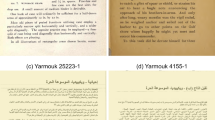Abstract
Characteristics of optical recognition programs are described from the standpoint of typical recognition program modules. Not only quality criteria for the separate character recognition but also parameters of other important stages of document input, such as character boundary segmentation, binarization, page segmentation, and storing results, are discussed in detail. The set of characteristics presented can be used for the optimization of both separate recognition stages and the whole process of document input.
Similar content being viewed by others
REFERENCES
Kazem, T., Borsack, J., and Condit, A., Evaluation of Model-Based Retrieval Effectiveness with OCR Text, ACM Trans. Information System, 1996, vol. 14, no. 1, pp. 64-93.
Haigh, S., Optical Character Recognition (OCR) as a Digitization Technology, Network Notes, no. 37, Information Technology Services National Library of Canada, 1996. http://www.nlc-bnc.ca/publications/netnotes/notes37.htm.
Portegys, T.E., A Search Technique for Pattern Recognition Using Relative Distances, IEEE Trans. Pattern Analysis Machine Intelligence, 1995, vol. 17, no. 9, pp. 910-912.
Cun, Y.Le., et al., Back-Propagation Applied to Handwritten Zip Code Recognition, Neural Computation, 1989, vol. 1, pp. 541-551.
Slavin, O.A., Tools for Management of Graphical Character Images Bases and Their Place in Recognition Systems, in Razvitie bezbumazhnykh tekhnologii v organizatsiyakh(Development of Paper-free Technologies for Offices), Moscow: URSS, 1999, pp. 277-289.
Wang, J. and Jean, J., Segmentation of Merged Characters by Neural Networks Shortest Path, Pattern Recognition, 1994, vol. 27, no. 5, pp. 649-658.
Arlazarov, V.L., Korol'kov, G.V., and Slavin, O.A., A Linear Criterion in OCR Problems, in Razvitie bezbumazhnykh tekhnologii v organizatsiyakh(Development of Paper-free Technologies for Offices), Moscow: URSS, 1999, pp. 17-23.
Arlazarov, V.L., Kuratov, P.A., and Slavin, O.A., Line Recognition for Printed Texts, in Metody i sredstva raboty s dokumentami(Methods and Tools for Paper Work), Moscow: URSS, 2000, pp. 31-51.
Wu, V., Manmatha, R., and Riseman, E.M., TextFinder: An Automatic System to Detect and Recognize Text in Images, IEEE Trans. Pattern Analysis Machine Intelligence, 1999, vol. 21, no. 11, pp. 1224-1229.
Klyahzkin, V., Shchepin, E., and Zingerman, K., Hierarchical Analysis of Multi-column Texts, Pattern Recognition Image Analysis, 1995, vol. 5, no. 1, pp. 1-12.
Author information
Authors and Affiliations
Rights and permissions
About this article
Cite this article
Arlazarov, V.L., Loginov, A.S. & Slavin, O.A. Characteristics of Optical Text Recognition Programs. Programming and Computer Software 28, 148–161 (2002). https://doi.org/10.1023/A:1015684114065
Issue Date:
DOI: https://doi.org/10.1023/A:1015684114065




